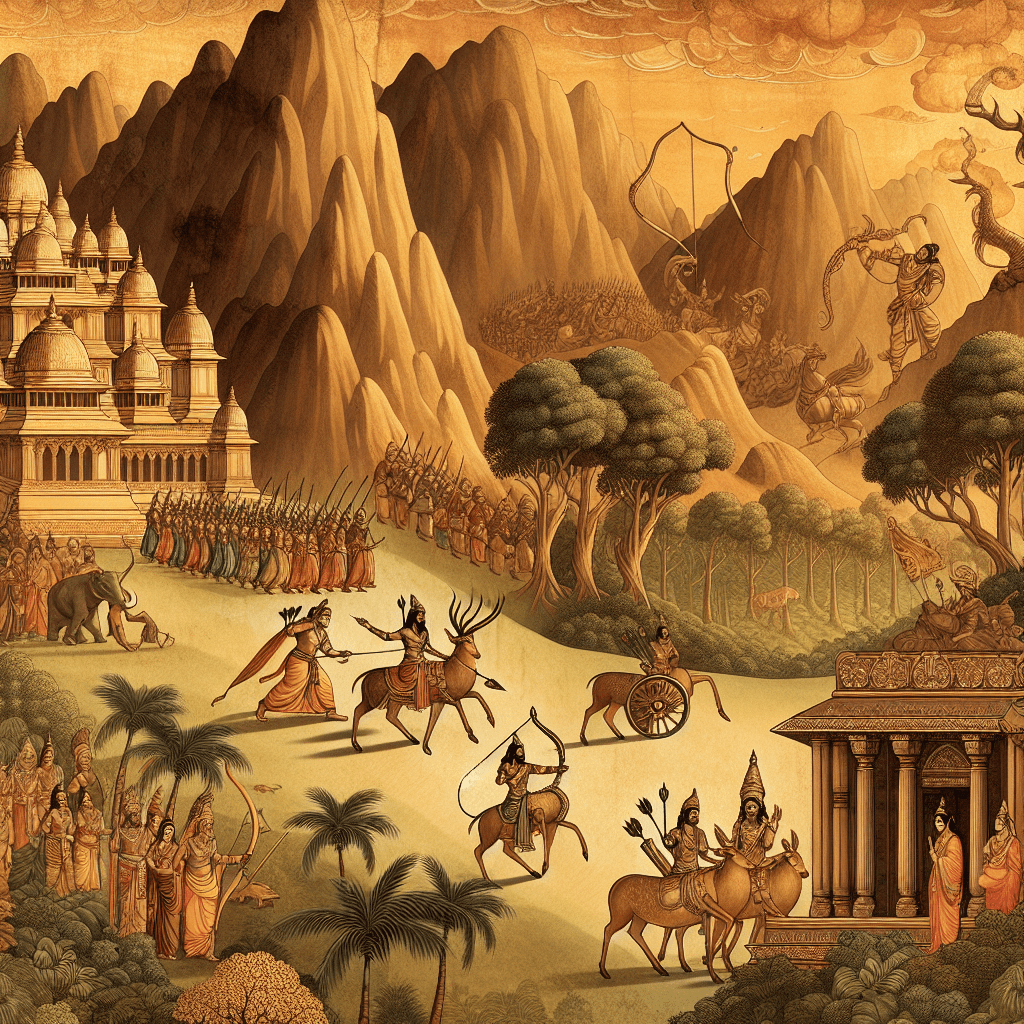All the information on this website is published in good faith and for general information purpose only. blog.medihertz.com does not make any warranties about the completeness, reliability and accuracy of this information.Read Our Disclaimer
-
Table of Contents
- Introduction
- The Legacy of Lord Ram: Impact on Indian Culture and Society
- Lessons from Lord Ram’s Leadership: Applying in Modern Times
- The Role of Sita in Lord Ram’s Journey: Beyond the Stereotypes
- Lord Ram’s Exile: A Symbol of Sacrifice and Duty
- The Epic Battle of Ram and Ravana: Uncovering the Truth
- The Birth of Lord Ram: Myth or Reality?
- Conclusion
Introduction
Lord Ram, also known as Rama, is a prominent figure in Hindu mythology and is considered to be the seventh avatar of the Hindu god Vishnu. He is the central character in the epic Ramayana, one of the most revered and influential texts in Hinduism. The story of Lord Ram is a tale of love, duty, and sacrifice, and has been passed down through generations as a source of moral and spiritual guidance. His story is not just a myth, but a reflection of the human experience and the eternal struggle between good and evil. In this introduction, we will explore the real story of Lord Ram and his significance in Hindu culture.The Legacy of Lord Ram: Impact on Indian Culture and Society
The story of Lord Ram is one that has been passed down through generations in Indian culture. It is a tale of love, sacrifice, and righteousness that has left a lasting impact on Indian society. Lord Ram, also known as Maryada Purushottam, is considered to be the seventh avatar of Lord Vishnu, one of the three main deities in Hinduism. His story, as depicted in the epic Ramayana, has not only shaped the religious beliefs of millions of people but has also influenced the cultural and societal norms in India. The legacy of Lord Ram can be seen in various aspects of Indian culture and society. One of the most prominent influences is in the concept of dharma, which refers to one’s duty or moral responsibility. Lord Ram is often portrayed as the epitome of dharma, as he always followed the path of righteousness and fulfilled his duties as a son, husband, and king. His unwavering commitment to dharma has inspired people to lead a virtuous life and has become an integral part of Indian values and ethics. Another significant impact of Lord Ram’s story is on the institution of marriage. Lord Ram’s love and devotion towards his wife, Sita, is considered to be the ideal example of a perfect marriage. Their union is seen as a symbol of love, trust, and companionship, which has influenced the way marriages are perceived in Indian society. The concept of Sita-Ram, where the wife is seen as an equal partner to her husband, has been ingrained in the minds of people and has helped in promoting gender equality in relationships. The character of Lord Ram has also played a crucial role in shaping the political landscape of India. He is often seen as the ideal king, who ruled with compassion, justice, and fairness. His reign is considered to be the golden age of India, where there was peace and prosperity. The concept of Ram Rajya, where the ruler is selfless and works for the welfare of his people, has been a source of inspiration for many leaders in India. Even today, Lord Ram’s legacy continues to influence political ideologies and policies in the country. Apart from these, Lord Ram’s story has also had a significant impact on the arts and literature of India. The epic Ramayana has been a source of inspiration for poets, writers, and artists for centuries. It has been retold in various forms, including plays, songs, and paintings, and has become an integral part of Indian culture. The values and morals depicted in the epic have been passed down through generations and continue to be relevant in today’s world. Lord Ram’s legacy is not limited to India alone; it has also influenced other countries and cultures. The story of Ramayana has been translated into several languages and has been adapted in various forms in countries like Indonesia, Thailand, and Cambodia. The values and teachings of Lord Ram have transcended borders and have become a part of the global cultural heritage. In conclusion, the impact of Lord Ram’s story on Indian culture and society is undeniable. His teachings and values have stood the test of time and continue to guide people in leading a righteous and virtuous life. The legacy of Lord Ram will continue to inspire generations to come and will remain an integral part of Indian identity. As the saying goes, “Ram naam japna, paraya maal apna” (Remember the name of Ram, but keep your belongings to yourself), Lord Ram’s story teaches us to be humble, compassionate, and selfless, and these are the values that will continue to shape Indian culture and society for years to come.Lessons from Lord Ram’s Leadership: Applying in Modern Times
Lord Ram, the seventh avatar of Lord Vishnu, is a revered figure in Hindu mythology. His story, as depicted in the epic Ramayana, is not just a tale of heroism and adventure, but also a source of valuable lessons on leadership. Despite being written thousands of years ago, the lessons from Lord Ram’s leadership are still relevant and applicable in modern times. Let us delve deeper into the real story of Lord Ram and explore the timeless lessons we can learn from his leadership. The first lesson we can learn from Lord Ram’s leadership is the importance of integrity. Lord Ram was known for his unwavering commitment to truth and righteousness. He never deviated from his principles, even when faced with difficult situations. In today’s world, where moral values are often compromised for personal gain, Lord Ram’s integrity serves as a reminder that true leaders must always uphold their values and principles, no matter the circumstances. Another crucial lesson we can learn from Lord Ram’s leadership is the power of empathy. Lord Ram was not just a leader, but also a compassionate and understanding human being. He always put himself in others’ shoes and made decisions that were fair and just. In today’s fast-paced world, where empathy is often overlooked, Lord Ram’s example teaches us the importance of understanding and considering others’ perspectives in our leadership roles. Lord Ram’s leadership also teaches us the value of teamwork. In the epic Ramayana, Lord Ram was accompanied by his loyal brother, Lakshman, and his devoted friend, Hanuman, on his journey to rescue his wife, Sita. Despite facing numerous challenges, they worked together as a team and overcame all obstacles. In today’s corporate world, where individual achievements are often prioritized, Lord Ram’s leadership reminds us that true success can only be achieved through teamwork and collaboration. One of the most significant lessons we can learn from Lord Ram’s leadership is the importance of staying calm and composed in the face of adversity. Lord Ram faced numerous challenges and setbacks, but he never lost his composure. He remained calm and focused, even in the most challenging situations. In today’s fast-paced and stressful work environments, Lord Ram’s example teaches us the value of staying calm and composed, even in the most trying times. Lord Ram’s leadership also teaches us the importance of leading by example. He never asked his followers to do anything he was not willing to do himself. He led from the front and set an example for others to follow. In today’s world, where leaders often delegate tasks and responsibilities, Lord Ram’s leadership reminds us that true leaders must lead by example and be willing to do what they expect from others. Finally, Lord Ram’s leadership teaches us the value of forgiveness and compassion. Despite being wronged by his own brother, Lord Ram forgave him and welcomed him back with open arms. He also showed compassion towards his enemies and never held grudges. In today’s world, where conflicts and grudges are prevalent, Lord Ram’s example teaches us the importance of forgiveness and compassion in leadership. In conclusion, the real story of Lord Ram is not just a mythological tale, but a source of valuable lessons on leadership. His unwavering integrity, empathy, teamwork, composure, leading by example, and forgiveness and compassion are timeless lessons that can be applied in modern times. As we navigate through our leadership roles, let us remember the teachings of Lord Ram and strive to become better leaders, not just for ourselves but for the betterment of society as a whole.The Role of Sita in Lord Ram’s Journey: Beyond the Stereotypes
 The story of Lord Ram is one that has been passed down for generations, with each retelling adding its own unique perspective and interpretation. However, one aspect of this epic tale that often gets overlooked is the role of Sita, Lord Ram’s wife. In popular culture, Sita is often portrayed as a meek and submissive character, but her true role in Lord Ram’s journey goes far beyond these stereotypes.
Sita, also known as Janaki, was not just a mere supporting character in Lord Ram’s journey. She was an equal partner, a source of strength and wisdom, and a symbol of unwavering devotion. From the very beginning, Sita’s presence in Lord Ram’s life was not a coincidence, but rather a divine plan.
According to the Hindu mythology, Sita was the incarnation of Goddess Lakshmi, the consort of Lord Vishnu. She was born to King Janaka and Queen Sunayana, who found her while plowing the fields. This is where her name, Sita, which means “furrow” in Sanskrit, comes from. From a young age, Sita displayed qualities of courage, intelligence, and compassion, which would later play a crucial role in Lord Ram’s journey.
When Lord Ram was exiled to the forest for 14 years, Sita chose to accompany him, despite the protests of her family. This decision was not made out of blind love, but rather out of her deep understanding of her husband’s duty and her own role in fulfilling it. Sita’s unwavering devotion to Lord Ram was not a sign of weakness, but rather a display of her inner strength and resilience.
During their time in the forest, Sita proved to be a valuable companion to Lord Ram. She was not just a dutiful wife, but also a skilled archer and a knowledgeable scholar. When Lord Ram was faced with challenges, Sita was always there to offer her support and guidance. In fact, it was Sita who suggested that Lord Ram seek the help of Hanuman in finding his brother, Laxman, who was kidnapped by Ravana.
Sita’s role in the battle against Ravana is often overshadowed by Lord Ram’s heroic deeds. However, it was her unwavering faith and courage that ultimately led to Ravana’s defeat. When Ravana tried to tempt Sita with his wealth and power, she remained steadfast in her devotion to Lord Ram. This act of defiance and strength is often overlooked, but it is a testament to Sita’s character and her unwavering love for her husband.
After the war, when Lord Ram was crowned as the king of Ayodhya, Sita’s role as a queen was not limited to just being a supportive wife. She was an active participant in the administration of the kingdom and was known for her wisdom and compassion. Sita’s presence in the palace brought prosperity and harmony to the kingdom, and she was loved and respected by all.
Despite her unwavering devotion and sacrifices, Sita’s character has often been reduced to that of a submissive and obedient wife. However, her true role in Lord Ram’s journey goes far beyond these stereotypes. She was a strong and independent woman who stood by her husband through thick and thin, and her unwavering love and devotion continue to inspire generations.
In conclusion, Sita’s role in Lord Ram’s journey is one that goes beyond the traditional stereotypes. She was not just a dutiful wife, but also a skilled warrior, a wise scholar, and a compassionate queen. Her unwavering love and devotion to Lord Ram serve as a reminder of the power of true love and the strength of a woman’s character. Sita’s story is one that deserves to be told and celebrated, for she is not just a supporting character, but a true hero in her own right.
The story of Lord Ram is one that has been passed down for generations, with each retelling adding its own unique perspective and interpretation. However, one aspect of this epic tale that often gets overlooked is the role of Sita, Lord Ram’s wife. In popular culture, Sita is often portrayed as a meek and submissive character, but her true role in Lord Ram’s journey goes far beyond these stereotypes.
Sita, also known as Janaki, was not just a mere supporting character in Lord Ram’s journey. She was an equal partner, a source of strength and wisdom, and a symbol of unwavering devotion. From the very beginning, Sita’s presence in Lord Ram’s life was not a coincidence, but rather a divine plan.
According to the Hindu mythology, Sita was the incarnation of Goddess Lakshmi, the consort of Lord Vishnu. She was born to King Janaka and Queen Sunayana, who found her while plowing the fields. This is where her name, Sita, which means “furrow” in Sanskrit, comes from. From a young age, Sita displayed qualities of courage, intelligence, and compassion, which would later play a crucial role in Lord Ram’s journey.
When Lord Ram was exiled to the forest for 14 years, Sita chose to accompany him, despite the protests of her family. This decision was not made out of blind love, but rather out of her deep understanding of her husband’s duty and her own role in fulfilling it. Sita’s unwavering devotion to Lord Ram was not a sign of weakness, but rather a display of her inner strength and resilience.
During their time in the forest, Sita proved to be a valuable companion to Lord Ram. She was not just a dutiful wife, but also a skilled archer and a knowledgeable scholar. When Lord Ram was faced with challenges, Sita was always there to offer her support and guidance. In fact, it was Sita who suggested that Lord Ram seek the help of Hanuman in finding his brother, Laxman, who was kidnapped by Ravana.
Sita’s role in the battle against Ravana is often overshadowed by Lord Ram’s heroic deeds. However, it was her unwavering faith and courage that ultimately led to Ravana’s defeat. When Ravana tried to tempt Sita with his wealth and power, she remained steadfast in her devotion to Lord Ram. This act of defiance and strength is often overlooked, but it is a testament to Sita’s character and her unwavering love for her husband.
After the war, when Lord Ram was crowned as the king of Ayodhya, Sita’s role as a queen was not limited to just being a supportive wife. She was an active participant in the administration of the kingdom and was known for her wisdom and compassion. Sita’s presence in the palace brought prosperity and harmony to the kingdom, and she was loved and respected by all.
Despite her unwavering devotion and sacrifices, Sita’s character has often been reduced to that of a submissive and obedient wife. However, her true role in Lord Ram’s journey goes far beyond these stereotypes. She was a strong and independent woman who stood by her husband through thick and thin, and her unwavering love and devotion continue to inspire generations.
In conclusion, Sita’s role in Lord Ram’s journey is one that goes beyond the traditional stereotypes. She was not just a dutiful wife, but also a skilled warrior, a wise scholar, and a compassionate queen. Her unwavering love and devotion to Lord Ram serve as a reminder of the power of true love and the strength of a woman’s character. Sita’s story is one that deserves to be told and celebrated, for she is not just a supporting character, but a true hero in her own right.
Lord Ram’s Exile: A Symbol of Sacrifice and Duty
The story of Lord Ram is one that has been passed down for generations, captivating the hearts and minds of people all over the world. It is a tale of love, sacrifice, and duty that continues to inspire and guide us even today. One of the most significant events in Lord Ram’s life is his exile, which is a symbol of his unwavering commitment to his duty and his sacrifice for the greater good. The exile of Lord Ram is a pivotal moment in the epic Ramayana, where he is forced to leave his kingdom and live in the forest for fourteen years. This event is often seen as a test of Lord Ram’s character and his ability to fulfill his duties as a prince and later as a king. It is a story that teaches us the importance of fulfilling our responsibilities, even in the face of adversity. The exile of Lord Ram was not a decision made by him, but rather a consequence of his father’s promise to his stepmother, Kaikeyi. She had asked for Lord Ram to be exiled and her son, Bharat, to be crowned as the king. Despite being devastated by this turn of events, Lord Ram accepted his fate with grace and humility. He did not question his father’s decision or harbor any resentment towards Kaikeyi. Instead, he saw it as his duty to fulfill his father’s promise and maintain the honor of his family. The exile of Lord Ram was not an easy one. He had to leave behind his beloved wife, Sita, and his brother, Lakshman, who chose to accompany him in his journey. They faced numerous challenges and obstacles in the forest, but Lord Ram remained steadfast in his duty. He protected the sages and the innocent creatures of the forest, fought against demons, and even helped the gods in their battles. He never wavered in his commitment to his responsibilities, even when it meant putting his own life in danger. The exile of Lord Ram is also a symbol of his sacrifice. He willingly gave up his comfortable life as a prince to live in the harsh conditions of the forest. He left behind his luxurious palace and all the comforts that came with it to fulfill his duty towards his family and his kingdom. This selfless act of sacrifice is a testament to Lord Ram’s character and his unwavering devotion to his duty. Lord Ram’s exile also teaches us the importance of detachment. Despite being a prince, he did not let his attachment to material possessions cloud his judgment. He understood that his duty towards his kingdom and his family was more important than any material wealth. This detachment allowed him to focus on his responsibilities and fulfill them without any distractions. The exile of Lord Ram is a story that continues to inspire us even today. It teaches us the importance of fulfilling our duties and responsibilities, even in the face of adversity. It reminds us that sacrifice and detachment are essential qualities in fulfilling our duties and living a meaningful life. Lord Ram’s exile is not just a part of his story, but a symbol of his unwavering commitment to his duty and his selfless sacrifice for the greater good.The Epic Battle of Ram and Ravana: Uncovering the Truth
The story of Lord Ram and his epic battle against the demon king Ravana is one that has been told and retold for centuries. It is a tale of good versus evil, of righteousness and sacrifice, and of the triumph of good over darkness. But how much of this story is based on truth and how much is just a myth? In this article, we will delve deeper into the real story of Lord Ram and the battle of Ram and Ravana, uncovering the truth behind this ancient epic. The story of Lord Ram begins with his birth in the kingdom of Ayodhya. He was the eldest son of King Dasharatha and Queen Kaushalya, and was destined to be the future king. However, due to a misunderstanding and the manipulation of one of King Dasharatha’s wives, Ram was sent into exile for fourteen years. This is where the story of his battle against Ravana truly begins. Ravana, the demon king of Lanka, had been terrorizing the world with his evil deeds. He had even kidnapped Sita, Lord Ram’s beloved wife, and taken her to his kingdom. This was the ultimate insult to Ram, and he vowed to rescue Sita and defeat Ravana. With the help of his loyal brother Lakshman and the monkey army led by Hanuman, Ram set out on his journey to Lanka. The battle between Ram and Ravana was not just a physical one, but also a battle of ideologies. Ravana represented the forces of evil, while Ram stood for righteousness and justice. This is evident in the way Ram fought the war. He never resorted to deceit or trickery, but instead fought with honor and integrity. This is what sets him apart from Ravana and makes him a true hero. The battle was fierce and lasted for many days. Both sides suffered heavy losses, but Ram’s determination and courage never wavered. He was aided by the divine weapons given to him by the gods, and with each passing day, he came closer to victory. Finally, in a final showdown, Ram and Ravana faced each other in a one-on-one battle. It was a battle of epic proportions, with both warriors displaying their incredible strength and skills. In the end, it was Ram who emerged victorious. He defeated Ravana and rescued Sita, bringing an end to the reign of terror and restoring peace to the world. But the victory came at a great cost. Ram had to make many sacrifices along the way, including losing his beloved wife Sita. Despite this, he remained true to his principles and emerged as a true hero, loved and revered by all. The story of Ram and Ravana’s battle is not just a myth, but a reflection of the eternal struggle between good and evil. It teaches us the importance of standing up for what is right, even in the face of adversity. It also shows us the power of faith and determination, as Ram’s unwavering belief in himself and the divine helped him overcome all obstacles. In conclusion, the epic battle of Ram and Ravana is not just a story, but a timeless lesson that continues to inspire and guide us. It is a reminder that good will always triumph over evil, and that true heroes are those who fight for justice and righteousness. So let us remember the real story of Lord Ram and his battle against Ravana, and strive to embody his virtues in our own lives.The Birth of Lord Ram: Myth or Reality?
The story of Lord Ram is one that has been passed down for generations, captivating the hearts and minds of millions. From the epic Ramayana to modern-day adaptations, the tale of Lord Ram’s life has been retold in various forms. But amidst all the retellings and interpretations, one question remains – was Lord Ram’s birth a myth or a reality? According to Hindu mythology, Lord Ram was born in Ayodhya, a city in the northern state of Uttar Pradesh in India. His birth is celebrated on the auspicious day of Ram Navami, which falls on the ninth day of the Hindu month of Chaitra. It is believed that Lord Ram was born to King Dasharatha and Queen Kaushalya, who had been longing for a child for many years. The story goes that King Dasharatha had three wives – Kaushalya, Kaikeyi, and Sumitra. However, none of them were able to bear him a child. In desperation, the king decided to perform a yagna (sacrificial ritual) to please the gods and ask for a child. The gods were pleased with the king’s devotion and granted him four sons – Lord Ram, Lakshman, Bharat, and Shatrughan. But some historians and scholars argue that this story is just a myth and that Lord Ram was not a real historical figure. They believe that the story of Lord Ram was created to establish the supremacy of Hinduism and to promote the idea of a perfect ruler. However, there is evidence to suggest that Lord Ram was indeed a real historical figure. The Ramayana, which is the primary source of Lord Ram’s story, is not just a religious text but also a historical one. It provides detailed descriptions of the geography, culture, and customs of ancient India. The Ram Setu, also known as Adam’s Bridge, is believed to be the bridge that Lord Ram and his army built to cross over to Lanka. This bridge is still visible today and is considered a significant archaeological site. Moreover, there are several other historical and archaeological sites associated with Lord Ram’s life. The Ayodhya temple, which is believed to be the birthplace of Lord Ram, is a popular pilgrimage site for Hindus. The city of Ayodhya itself is considered a sacred place and is mentioned in ancient texts like the Mahabharata and the Puranas. Another piece of evidence that supports the existence of Lord Ram is the existence of the Ram Sethu or the Rama’s Bridge in Sri Lanka. This bridge is believed to have been built by Lord Ram and his army to rescue his wife, Sita, from the demon king Ravana. The bridge is made of limestone shoals and is considered a significant engineering marvel. Furthermore, there are several inscriptions and artifacts found in various parts of India that mention Lord Ram’s name. For instance, the Ramkot Fort in Ayodhya is believed to be the site where Lord Ram’s palace once stood. The fort has inscriptions and carvings that depict scenes from the Ramayana, further solidifying the belief that Lord Ram was a real historical figure. In conclusion, while some may argue that Lord Ram’s birth is a myth, there is enough evidence to suggest that he was indeed a real historical figure. The story of Lord Ram has stood the test of time and continues to inspire people to this day. Whether one believes in the divinity of Lord Ram or not, there is no denying the impact his story has had on millions of people around the world.Conclusion
In conclusion, the real story of Lord Ram is a significant part of Hindu History and has been passed down through generations. It is believed that Lord Ram was an incarnation of Lord Vishnu and his story teaches important lessons about righteousness, devotion, and the triumph of good over evil. While there may be different versions and interpretations of his story, the essence remains the same – Lord Ram’s unwavering faith and dedication to his duties and principles continue to inspire people to this day. His story serves as a reminder of the power of faith and the importance of upholding moral values in the face of adversity.All the information on this website is published in good faith and for general information purpose only. blog.medihertz.com does not make any warranties about the completeness, reliability and accuracy of this information.Read Our Disclaimer
Follow us on
E Mail us
Donate and support us for this Wonderful Cause.
Your Smallest Effort Can help us
Create a Better World.

Or, Just Pay For A coffee To Medihertz

Further Read
In today’s fast-paced and stressful world, taking care of our mental health has become more important than ever before. And what better way to boost our well-being than by finding inspiration in the wise words of others? In this article, we have curated 10 inspiring mental health quotes that are sure to uplift your spirits and provide a much-needed dose of motivation. Read More
When it comes to enhancing your mental wellbeing, various studies have presented compelling evidence supporting the implementation of five crucial steps. By consciously incorporating these practices into your daily routine, you can effectively elevate your mental health and overall sense of wellbeing. Engaging in these activities has the potential to foster a more positive outlook on life, enabling you to fully embrace its opportunities and experiences. Read More








